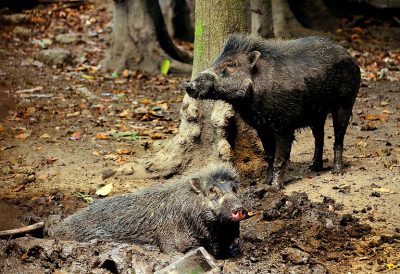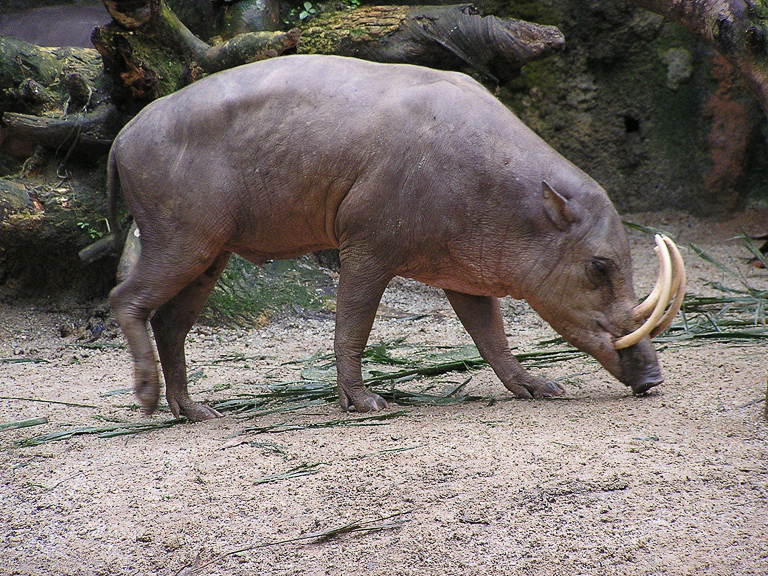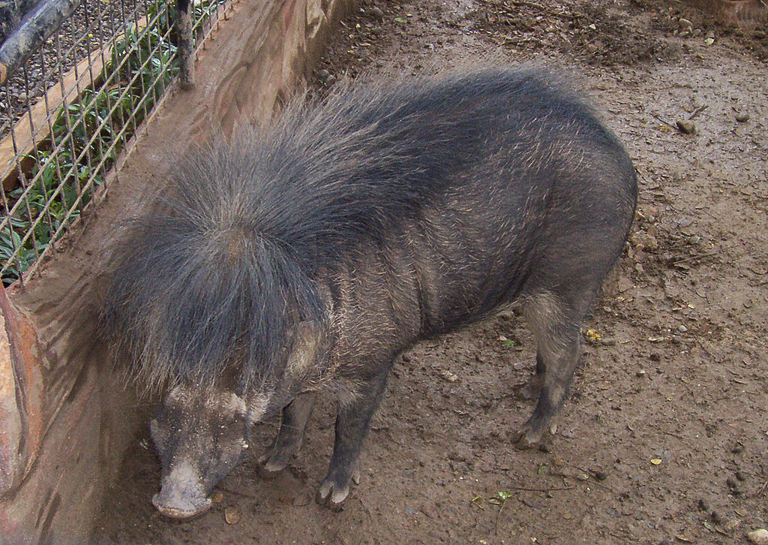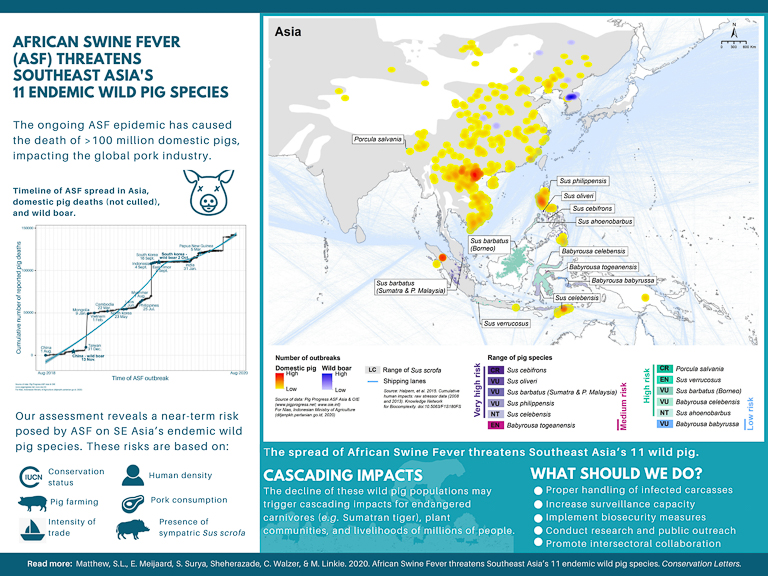Southeast Asian Wild Pigs Confront Deadly African Swine Fever Epidemic

Since the 2018 emergence of African swine fever in China, the viral disease has torn through Asia, leaving behind a trail of economic devastation. It’s witheringly fatal to pigs but harmless to humans, and at least 100 million pigs have either been cut down by ASF or culled in a grisly campaign aimed at corralling the disease.
Over the past two years, the disease has hopped China’s land and sea borders and swept across pig-rich Southeast Asia. Previously unknown to the immune systems of the region’s domestic and wild pigs, the virus moves readily from pig to pig, ripping through a single farm in a matter of weeks and leaving listless, coughing, dying pigs in its wake.
Now, according to recent research, it could also jeopardize the foundations of food security and local economies, threaten endangered animals — including but not limited to Southeast Asia’s kaleidoscope of unique wild pig species — and imperil entire ecosystems. In a study published Dec. 21 in the journal Conservation Letters, a team of biologists is calling on countries across Southeast Asia to use every tool available to halt the spread of the disease.
Anchors of the ecosystem
Southeast Asia has a lot of islands — more than 25,000, at last count. As with Darwin’s finches in the Galápagos, evolution has hewn a remarkable cast of curious species living on the islands.
Few animal families in Southeast Asia exemplify this speciation over generations more aptly than pigs, or “suids,” if you’re a biologist. There are several varieties of both warty and bearded pigs, as well as a short-slung (and -legged) member of the Porculagenus called the pygmy hog. Several Babyrousa species stalk the islands of Indonesia, sporting tusk-like canines that burst from their skulls like an animal from the pages of Arthur Conan Doyle’s The Lost World. In all, scientists have found 11 suid species in Southeast Asia.
Confined in some cases to just a few islands, these species tend to have naturally small populations. That, combined with surging human settlement and the related loss of the pig habitat to deforestation for timber and agriculture, has winnowed those numbers even further. In 2016, for example, scientists estimated that only about 1,000 adult Togian babirusa (Babyrousa togeanensis) lived on its namesake island chain in Indonesia.
With such small populations, these pigs teeter on a precarious edge, where a single calamity — such as a deadly disease to which they have no developed immune response — could wipe them out, and it’s put scientists on alert across Southeast Asia.
Image on the right: A Sulawesi babirusa (Babyrousa celebensis). Image by Masteraah at German Wikipedia, via Wikimedia Commons(CC BY-SA 2.0 DE).

Particularly worrisome have been reported mass wild pig deaths in places like India, home to the last few hundred pygmy hogs, as well as on the islands of Sumatra, Java and Borneo, said Matthew Luskin, a wildlife ecologist at Australia’s University of Queensland and the study’s lead author, in an email to Mongabay. Recently, scientists from Danau Girang Research Centre in northern Malaysian Borneo happened on dozens of dead bearded pigs (Sus barbatus barbatus).
Luskin said the arrival of ASF in Borneo’s wild pigs would have been the realization of scientists’ “worst nightmares.” But on Feb. 9, government officials said that no evidence of ASF had turned up in samples taken from the dead animals, according to The Star newspaper. They’re still unsure of what caused the deaths, though they suspect the animals may have been poisoned.
Addressing the threat of the disease more broadly turns out to be complicated. The ongoing COVID-19 pandemic could make it more difficult to marshal resources for a disease that hasn’t been shown to infect humans or jump from pigs to other animals, Luskin added. What’s more, farmers who see wild pigs as a nuisance might be less inclined to support measures to control a disease like ASF.
But even if it remains within the pig family, the effects of the disease could still reverberate through ecosystems and human communities across the region, the authors write.
Image below: Critically endangered Sumatran tigers, pictured here in Indonesia, rely on wild pig species as prey in parts of their range. Image by Rhett A. Butler/Mongabay.

On the surface, the disease imperils the survival of Southeast Asia’s wild pig species, several of which are listed as endangered or critically endangered on the IUCN Red List. But these animals also serve vital functions in their home ecosystems: Their hooves and fondness for rooting around for food help till the soil and encourage plant growth. And they’re a critical source of food for critically endangered predators, such as the Javan leopard (Panthera pardus melas) and the Sumatran tiger (Panthera tigris sumatrae).
For people living in many parts of Southeast Asia, farm-raised and wild pigs are a primary source of protein and income, even in Indonesia, where the predominantly Muslim majority avoids pork. Luskin said the disease first popped up in Indonesia in the port cities of Medan on the island of Sumatra and Denpasar on Bali, both home to large non-Muslim populations.
If the disease wipes out local pig populations, “the impact on those already threatened species and on the livelihoods of people would be catastrophic,” said Benoît Goossens, the director of Danau Girang. Goossens was not involved in the study.
“Southeast Asian governments need to recognize that this is a large social and environmental problem in the making with potentially massive impacts if not controlled early on,” Luskin told Mongabay.
‘A precautionary approach’
Image on the right: A Philippine warty hog (Sus philippensis). Image by Lsj via Wikimedia Commons (CC BY-SA 3.0).

To date, information on the spread of the disease, the potential for spillovers from domesticated to wild pigs, and the efficacy of control measures in Southeast Asia is scant. So Luskin and his colleagues set out to figure out what’s known about the disease and where the gaps lie.
The team began by plotting out the known outbreaks of the disease, starting with its arrival in China in mid-2018. From their examination of shipping data, they concluded that the disease likely spread through trade. In Africa, where the disease originated, ticks harbor the virus and carry it between pig populations. But so far, scientists haven’t yet determined if Asian tick species are also a vector.
Once the virus surfaces, wild boars, which are the same species (Sus scrofa) as domestic pigs and the most ubiquitous wild pig in Southeast Asia, help circulate the disease.
The scientists also mapped out the known ranges of each of the region’s 11 wild pig species. They then assigned an overall risk of each pig species’ or subspecies’ susceptibility to ASF based on factors such as the density of nearby human populations, the local appetite for pork and pig farming in the area, each species’ conservation status, and whether it overlaps with wild boar territories.

An infographic tracking the timeline and geographic spread of African swine fever in Asia. Image by Luskin et al., 2020.
The risk posed by ASF to the hairy babirusa (Babyrousa babyrussa) — literally “deer-pig” in Indonesian — is relatively low. Human communities in its range are sparsely populated, and neither pig farming nor pork consumption is very common. By contrast, the Visayan warty pig (Sus cebifrons), which lives in six of the Visayan Islands in the central Philippines, is at “very high” risk: There’s a lot of trade in pigs and pork within its range, and the species’ numbers are already low enough to warrant a designation of critically endangered by the IUCN.
Lowering these risks and minimizing the losses to both wildlife and people will require a host of solutions, the authors write, many relying on a precautionary approach advocated by other experts as well.
“It is important for the wildlife and veterinarian authorities to be extremely vigilant and treat suspicious deaths of wild pigs very seriously,” Goossens said in an email. He and the Danau Girang staff are currently working with Malaysian authorities to determine what killed as many as 60 Sunda bearded pigs (Sus barbatus barbatus) in early February 2021.
Fajar Sumping, Indonesia’s animal health director with the Ministry of Agriculture, told Mongabay that the ministry has been communicating with provincial veterinarians to prepare for possible ASF outbreaks since 2018. The government also has a health information system for animals called i-sikhnas, which allows veterinarians and farmers alike to report suspected cases of animal disease for follow-up.
“Through infographics that we distribute on social media, radio and ground campaign,” Fajar said, “the public are being informed and educated to actively participate in recognizing the symptoms of ASF, how to report them and how to carry out simple biosecurity actions.”
Image below: A Sunda bearded pig (Sus barbatus) in Malaysian Borneo. Image by Quinet via Wikimedia Commons (CC BY-SA 4.0).

Luskin noted that certain biosecurity measures, such as testing, the proper disposal of carcasses, and controlling the movement of animals and trade, are more feasible for large pork producers. But they are “practically impossible” for small family farms, he said. That means authorities will need to exert more control over the pork trade, even halting it completely if an outbreak is suspected.
He and his colleagues also said that collecting saliva samples for testing from wild pigs using bait could help to verify whether and where the disease might be spreading, along with stepping up in-the-field monitoring.
“What may [be] useful is the enhanced surveillance with active patrolling to look for dead wild boar and immediate testing and imposing restrictions to infected areas,” Sheherazade, a conservation scientist with WCS and co-author of the study, said in an email.
Communities living near wild pig ranges will be crucial to curbing disease transmission, Luskin said.
“[L]ocal traditional, commercial or recreational hunters are the first line of defence of the disease spreading as they are likely the first to notice whether and where the disease is affecting wild populations,” he said.
Image on the right: Wild pigs also help sustain Javan leopards, another critically endangered carnivore in Southeast Asia. Image by Anaxibia via Wikimedia Commons (CC BY-SA 3.0).

The authors also write that the scientific community needs to invest in continued research to determine which vectors pose the greatest risk. Scientists also don’t currently have enough data about the ecology of these animals, such as the size of the groups they live in, the team writes. Nor do they have up-to-date numbers for many of the species, apart from a general consensus that the populations are generally pretty small.
It’s that last point that is particularly concerning. Elsewhere, pigs can and have adapted to live with ASF. In Africa, the disease lies in wait more or less harmlessly in warthogs (Phacochoerus africanus), and even domestic pigs seem to have evolved some ability to cope with the disease since it was first introduced from Europe 400 or 500 years ago.
“If the disease persists across Asia, and there is no doubt that it will,” Luskin said, “then at some point in time it will similarly become endemic.”
The question then becomes whether the small — tiny, in some instances — populations of Southeast Asia’s distinctive wild pig species will be able “to buffer the high mortalities of the initial outbreaks,” he said, with the region’s ecological health hanging in the balance.
*
Note to readers: please click the share buttons above or below. Forward this article to your email lists. Crosspost on your blog site, internet forums. etc.
Hans Nicholas Jong contributed reporting.
John Cannon is a staff features writer with Mongabay. Find him on Twitter: @johnccannon
Sources
Luskin, M. S., Meijaard, E., Surya, S., Sheherazade, Walzer, C., & Linkie, M. (2020). African swine fever threatens Southeast Asia’s 11 endemic wild pig species. Conservation Letters. doi:10.1111/conl.12784
Featured image: Visayan warty pigs (Sus cebifrons) at a wallow in the Philippines. Image by Shukran888 via Wikimedia Commons(CC BY-SA 4.0).

